What Is COBOL?
COBOL, short for Common Business Oriented Language, is a high-level programming language dating back to the late 1950s. It was created for business, finance, and administrative systems, and became a key player in enterprise mainframe environments. Its syntax resembles natural English, making it accessible compared to other programming languages of its time.
Despite its age, COBOL remains important for legacy systems across industries, particularly in banking and government sectors where it supports critical operations. COBOL code is typically verbose, promoting clarity through lengthy code statements, which can ease debugging and maintenance.
What Is Java?
Java, released by Sun Microsystems in 1995, is a versatile high-level programming language widely used across various platforms. Known for its “write once, run anywhere” capability, Java is favored for web applications, enterprise solutions, and mobile platforms, notably Android development. It uses an object-oriented approach, which supports modular, scalable, and maintainable code, enabling collaboration amongst large development teams.
Java’s popularity is fueled by its ecosystem, extensive libraries, and a large professional community. Supported by continuous updates, it remains relevant, applicable to modern technological demands. Its compatibility with modern tech stacks makes Java an attractive choice for enterprises seeking innovation and future readiness.
Why Migrate COBOL to Java?
Here are some of the main reasons to prefer Java over COBOL:
- Talent acquisition and retention: Migrating from COBOL to Java broadens the talent pool, as Java developers are more abundant than their COBOL counterparts. Additionally, attracting younger professionals keen on modern languages strengthens team diversity and innovation.
- Cost efficiency: COBOL systems often run on expensive mainframe infrastructure, whereas Java applications are deployable on cost-effective cloud platforms or commodity hardware. This transition can reduce both capital and operational expenses. The costs associated with hiring and training COBOL developers typically exceed those for Java personnel.
- Integration with modern technologies: Java integrates with more technologies than the often-isolated COBOL ecosystems. Java supports APIs and microservices architectures, enabling scalable, modular applications that interact with contemporary software and platforms.
- Scalability and performance: Java’s architecture inherently supports scalability, crucial for organizations expecting growth. Its performance in distributed computing environments outperforms older monolith mainframe systems, which COBOL usually operates on. Java’s multi-threading capabilities and extensive optimization tools allow applications to scale in response to demand without extensive redevelopment.
The Role of Generative AI in Migrating COBOL to Java
Generative AI tools are increasingly used to support the migration from COBOL to Java by automating parts of the transformation process and reducing manual effort. These tools help bridge the gap between legacy code and modern architectures by interpreting existing COBOL programs and generating equivalent Java code.
Generative AI can analyze COBOL code structure and semantics, then propose and generate corresponding Java classes, methods, and data models. This includes automated mapping of COBOL identifiers to Java equivalents, enabling teams to focus on refining logic rather than rewriting boilerplate code.
By incorporating tools in development environments such as Visual Studio Code, developers can manage both COBOL and Java projects in unified or multi-root workspaces. Generative AI also supports customization during the transformation process. Developers can review, edit, and refine suggested Java code elements—such as class names, method signatures, and variables—before committing to generation.
AI-assisted migration helps standardize the process of code generation, making it easier to maintain consistency across large projects. Dependencies and project structures can be configured in advance, allowing generated Java code to integrate smoothly into existing build systems like Gradle or Maven.
Challenges of Migrating from COBOL to Java
Organizations often face the following issues when migrating COBOL systems to Java.
Legacy Code Complexity
COBOL systems are often developed and patched over decades. The original developers may no longer be available, and documentation is frequently incomplete or entirely absent. This creates a knowledge gap that makes understanding the full behavior of the system extremely difficult. The codebase might include non-standard constructs, embedded business rules, and platform-specific optimizations that are tightly coupled with mainframe hardware.
Data Structure Differences
COBOL applications often use fixed-width records, packed decimal formats (COMP-3), and EBCDIC encoding. These formats are efficient on mainframes but foreign to Java-based systems, which rely on variable-length records, Unicode strings, and object-based representations. Transforming legacy data formats requires careful mapping and conversion routines..
Mainframe Dependencies
COBOL applications often depend on mainframe-specific components like CICS (Customer Information Control System), IMS (Information Management System), JCL (Job Control Language), and VSAM (Virtual Storage Access Method). Java environments lack direct equivalents, requiring replacements such as Spring Batch, JMS, or cloud-native orchestration tools. Replicating the reliability of these legacy systems is not always possible.
Learn more in our detailed guide to COBOL mainframe
Performance Differences
Mainframe systems are engineered for consistent, high-throughput performance, and COBOL applications are optimized to take advantage of this hardware. Java relies on just-in-time (JIT) compilation and garbage collection, which can introduce latency or unpredictable pauses under certain conditions. For high-volume applications, this variability can become a concern.
Notable COBOL to Java Migration Tools
1. Swimm
Swimm’s Application Understanding Platform helps solve one of the biggest challenges in modernization – the lack of understanding of existing applications. Successfully converting code to Java that is usable and efficient requires using the right business rules and logic, not the existing code with its decades of complexity and accumulation of dead code. Swimm’s generated understanding is used with AI coding tools or by developers to then create the Java application.
Swimm is able to be deployed in highly secure environments and uses deterministic static analysis and generative AI to produce proven, reliable and cost-effective insights.
Key features include:
- Business rule extraction: Accurately extracts all the business rules and logic in the codebase.
- Architectural overviews: Finds and explains the component architecture of the application and breaks down programs, jobs, flows and dependencies.
- Natural language: Turns vague program and variable names into descriptive names for quickly understanding connections and flows.
- Customizable support: Supports complex and proprietary implementations of COBOL, CICS, and PL/I through language parsers and company specific plug-ins.
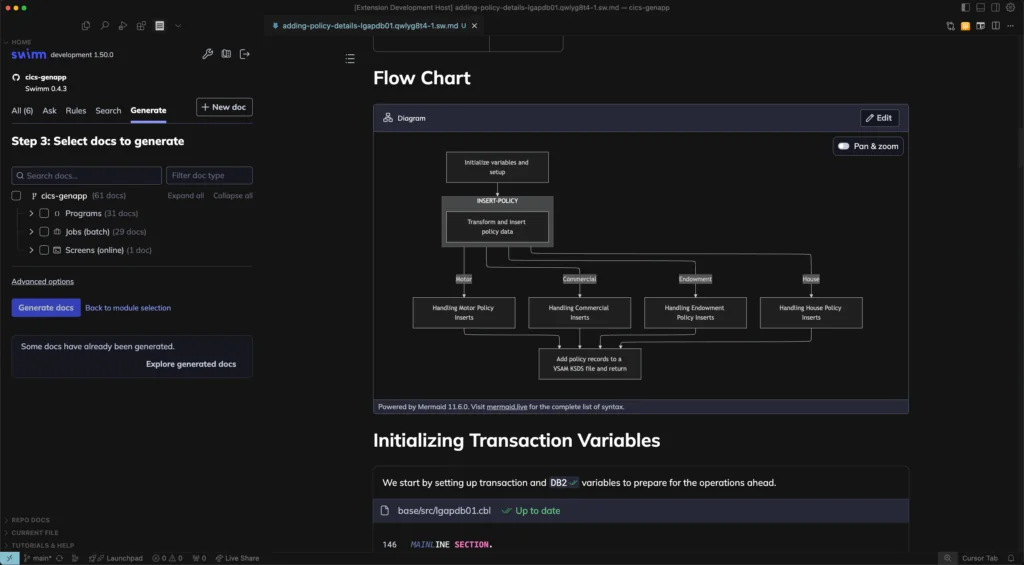
2. IBM Watsonx Code Assistant for Z
IBM watsonx Code Assistant for Z is a generative AI-powered solution to support mainframe application modernization. It helps organizations transform legacy COBOL applications into modern Java systems through automation, code comprehension, and incremental refactoring.
Key features:
- Application lifecycle support: Enables discovery, explanation, refactoring, transformation, and testing of COBOL applications in a single toolchain.
- Generative AI tailored for mainframes: Uses a fine-tuned large language model trained on COBOL and other mainframe languages to boost accuracy and context awareness.
- Incremental modernization: Supports gradual refactoring to maintain interoperability between COBOL and Java, reducing disruption and cost.
- Code understanding and visualization: Helps developers comprehend applications with visual maps of dependencies and relationships across codebases.
- IDE integration: Embedded directly into developer environments.

Source: IBM
3. AdvanceWorks
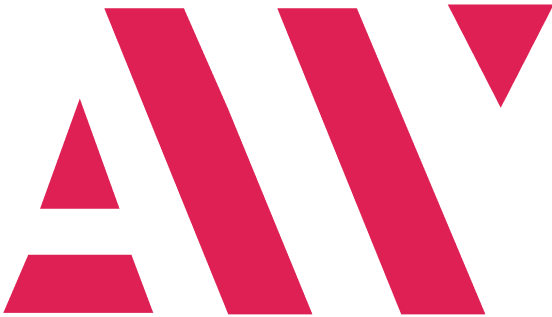
AdvanceWorks partnered with a major European bank to lead a generative AI-driven migration of its master financial database from COBOL to a modern .NET framework. The project aimed to improve operational resilience and reduce long-term costs. Generative AI helped accelerate the migration, improve code reliability, and maintain domain-specific accuracy.
Key features:
- Generative ai-powered migration: Translates COBOL to .NET with AI-driven code generation, ensuring accuracy in financial logic.
- Domain-specific optimization: Tailored for financial operations, supporting the migration of high-value, high-transaction workloads.
- Cost reduction and efficiency gains: Lowers maintenance costs by eliminating outdated systems and transitioning from external service providers to internal operations.
- Focused team collaboration: Delivered by a small, integrated team to maintain tight coordination and reduce overhead in communication and project management.
- Legacy modernization: Positions the institution for future growth with a scalable, maintainable architecture.
4. Unqork
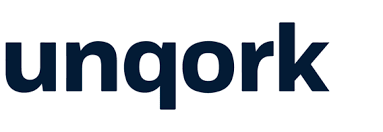
In COBOL migration scenarios, Unqork acts as both an accelerator and a destination: generative AI interprets and extracts business logic from undocumented COBOL systems, while Unqork provides a visual, no-code environment where those functions are rebuilt, extended, and maintained.
Key features:
- Generative AI-powered discovery & refactoring: Automates the extraction and transformation of business logic from COBOL.
- Codeless development: Allows users to create, update, and scale applications using a visual interface.
- No future migrations: Applications built in Unqork are not bound to any programming language, removing the need for future re-platforming or code-based modernization.
- Data-as-application architecture: Stores business logic as structured data (e.g., JSON), making applications composable, interpretable, and modifiable.
- Security & compliance: Offers support for SOC 2 Type II, ISO, HIPAA, and other compliance standards.
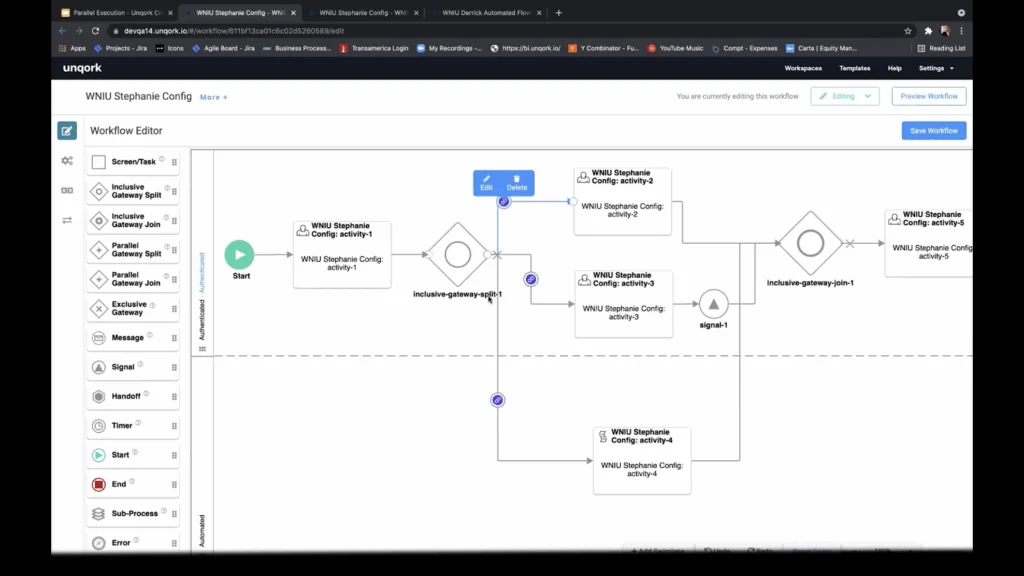
Source: Unqork
5. Persistent Systems

Persistent Systems uses an AI-first approach to COBOL-to-Java migration through a combination of domain expertise, generative AI, and a multi-agent framework. It introduces agents that collaborate to analyze, generate, and refine Java code from legacy COBOL systems.
Key features:
- Multi-agent framework for code migration: Uses AI agents for generation, review, and refinement of Java code from COBOL inputs.
- Coder agent: Translates COBOL structures into Java, applying object-oriented principles and modern design patterns.
- Reviewer agent for optimization: Ensures the translated code is syntactically correct, optimized for performance, and aligned with coding standards.
- User proxy agent for oversight: Enables domain experts to guide the migration by injecting organizational context and feedback into the agent workflow.
- Reduced manual coding effort: Automates the most tedious phases of migration.
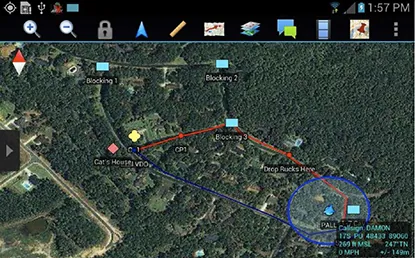
Source: Persistent Systems
Best Practices for Migrating COBOL to Java with GenAI
Here are some important practices to consider when migrating COBOL systems to Java.
1. Interpreting Complex Business Logic
Generative AI models can struggle to correctly interpret business logic embedded in decades-old COBOL code. These systems often include undocumented behaviors, hardcoded workarounds, and implicit domain rules that were never formally specified. AI-generated code may misrepresent or oversimplify these rules, leading to functional errors.
To mitigate this, teams must validate AI-generated logic against business requirements. Subject matter experts (SMEs) should review critical components of the translated code, especially in high-impact domains like finance or insurance. Combining automated translation with human-in-the-loop verification ensures alignment with legacy system behavior.
2. Managing Incomplete or Ambiguous Inputs
AI models depend on well-formed, unambiguous input to generate accurate code. In practice, COBOL codebases often lack documentation, include dead code, or rely on environment-specific configurations that aren’t captured in source files. These gaps lead to hallucinations or inaccurate translations by the AI.
Before applying generative AI, teams should clean and prepare COBOL inputs. This includes removing obsolete code, consolidating dependencies, and standardizing syntax. AI output should be treated as a draft requiring rigorous testing and augmentation rather than as production-ready code.
3. Ensuring Code Quality and Maintainability
AI-generated code may follow syntactic correctness but still fail in structural or architectural quality. It may produce procedural Java code that mirrors COBOL patterns instead of embracing object-oriented principles, leading to bloated, non-modular codebases. This limits long-term maintainability.
Enforce code quality standards using automated linters, static analysis tools, and code reviews. Refactor AI output to introduce appropriate abstractions, reuse patterns, and encapsulate functionality. Establish architectural guidelines that steer the AI toward consistent, maintainable code structure.
4. Aligning Generated Code with Modern Frameworks
COBOL programs are typically monolithic and tightly coupled to mainframe-specific features, while Java applications rely on modular frameworks like Spring Boot, Hibernate, or Jakarta EE. Generative AI often lacks context to select the most appropriate modern equivalents for legacy constructs, resulting in mismatches or inefficient implementations.
Integrate framework-specific templates or code scaffolding tools to guide the AI during generation. Predefine mappings between COBOL services (e.g., CICS transactions) and Java equivalents (e.g., REST APIs or message queues). Align output with the organization’s existing tech stack to reduce post-migration integration effort.
5. Addressing AI Transparency and Traceability
Generative AI does not inherently produce explanations or traceability for its decisions. This makes it difficult to audit how a specific Java method was derived from a COBOL paragraph, which is critical in regulated industries. Lack of transparency hinders trust and impedes debugging.
Adopt tools or workflows that log AI prompts, intermediate steps, and final outputs. Annotate translated code with references to original COBOL source lines. Use visualization tools to map COBOL components to their Java counterparts for easier traceability and compliance auditing.
Conclusion
COBOL-to-Java migration presents a strategic opportunity for organizations to modernize legacy systems and align with contemporary technology demands. By transitioning from outdated architectures to scalable, maintainable Java-based solutions, organizations can reduce operational risks, improve agility, and tap into a broader talent pool. However, successful migration requires careful planning, correct data handling practices, and awareness of the technical challenges involved.